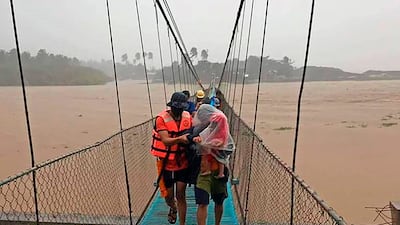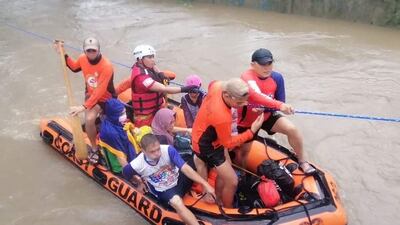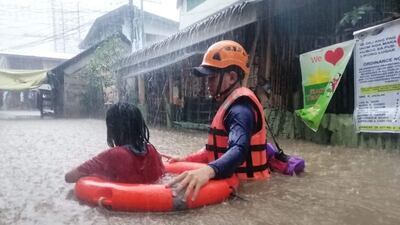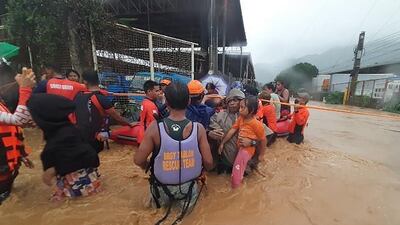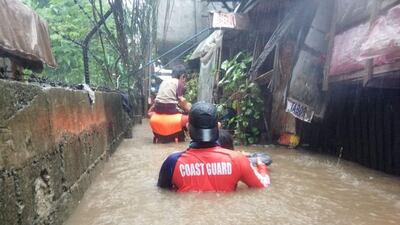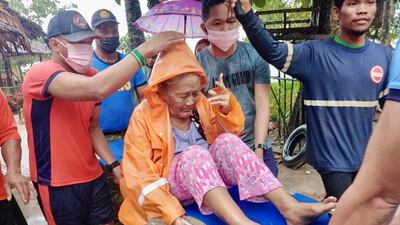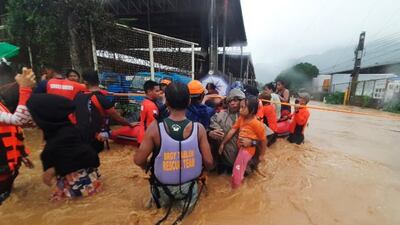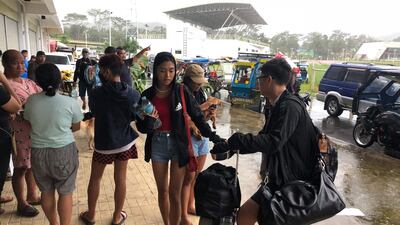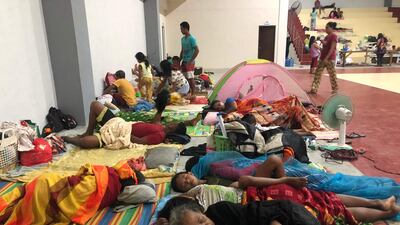Tens of thousands of people in the Philippines have fled their homes and beachfront resorts as a powerful typhoon lashed the archipelago on Thursday.
Authorities say more destructive winds and torrential rain could follow.
Typhoon Rai was driven by powerful winds as it barrelled towards central and southern regions of the vast archipelago, the state weather agency said.
It said the storm made landfall at 1.30pm local time on Siargao Island, with sustained winds of 185kph and gusts of up to 230kph.
"Destructive typhoon-force winds ... may bring moderate to heavy damage to structures and vegetation," the weather agency said.
More than 45,000 people have sought emergency shelter as the storm charged across the Pacific Ocean, the national disaster agency said. Officials said about 10,000 villages lie in the projected path of the typhoon, which has a 400-km-wide rain band and is one of the strongest to hit the country this year.
Those felling included domestic tourists visiting the country's famous beaches and diving spots. Foreign travellers are still banned from entering the Philippines under Covid-19 restrictions.
The Philippines is among the hardest-hit countries by the pandemic in South-east Asia, with confirmed infections of more than 2.8 million and more than 50,000 deaths.
Crowding in evacuation centres was complicating efforts to keep people safely distanced after health authorities detected the country’s first infections caused by the Omicron variant of the coronavirus.
The typhoon has led to scores of flights being cancelled and dozens of ports temporarily closed as the weather bureau said several metre-high storm surges in the sea could cause "life-threatening flooding" in low-lying coastal areas.
Several southern and central provinces were on typhoon alert. Residents were warned to stay away from coastal and low-lying villages and other high-risk areas due to possible flash floods, landslides and tidal surges in or near the typhoon’s path.
The coastguard said it has prohibited sea voyages in high-risk regions, leaving about 4,000 passengers and ferry and cargo ship workers stranded. Coastguard personnel and boats were on standby, it said.
Rai, locally named Odette, arrived late in the typhoon season, with most cyclones developing between July and October. It is expected to sweep across the Visayas region and Mindanao and Palawan islands, before arriving over the South China Sea on Saturday and heading towards Vietnam.
The Philippines – ranked as one of the world's most vulnerable places to the effects of a warming planet – is lashed by an average of 20 storms and typhoons every year, which typically wipe out harvests, homes and infrastructure in already impoverished areas.
The biog
Hometown: Birchgrove, Sydney Australia
Age: 59
Favourite TV series: Outlander Netflix series
Favourite place in the UAE: Sheikh Zayed Grand Mosque / desert / Louvre Abu Dhabi
Favourite book: Father of our Nation: Collected Quotes of Sheikh Zayed bin Sultan Al Nahyan
Thing you will miss most about the UAE: My friends and family, Formula 1, having Friday's off, desert adventures, and Arabic culture and people
How to avoid crypto fraud
- Use unique usernames and passwords while enabling multi-factor authentication.
- Use an offline private key, a physical device that requires manual activation, whenever you access your wallet.
- Avoid suspicious social media ads promoting fraudulent schemes.
- Only invest in crypto projects that you fully understand.
- Critically assess whether a project’s promises or returns seem too good to be true.
- Only use reputable platforms that have a track record of strong regulatory compliance.
- Store funds in hardware wallets as opposed to online exchanges.
UAE currency: the story behind the money in your pockets
Greatest Royal Rumble results
John Cena pinned Triple H in a singles match
Cedric Alexander retained the WWE Cruiserweight title against Kalisto
Matt Hardy and Bray Wyatt win the Raw Tag Team titles against Cesaro and Sheamus
Jeff Hardy retained the United States title against Jinder Mahal
Bludgeon Brothers retain the SmackDown Tag Team titles against the Usos
Seth Rollins retains the Intercontinental title against The Miz, Finn Balor and Samoa Joe
AJ Styles remains WWE World Heavyweight champion after he and Shinsuke Nakamura are both counted out
The Undertaker beats Rusev in a casket match
Brock Lesnar retains the WWE Universal title against Roman Reigns in a steel cage match
Braun Strowman won the 50-man Royal Rumble by eliminating Big Cass last
The specs
Engine: 2.0-litre 4-cyl turbo
Power: 247hp at 6,500rpm
Torque: 370Nm from 1,500-3,500rpm
Transmission: 10-speed auto
Fuel consumption: 7.8L/100km
Price: from Dh94,900
On sale: now
Killing of Qassem Suleimani
Normcore explained
Something of a fashion anomaly, normcore is essentially a celebration of the unremarkable. The term was first popularised by an article in New York magazine in 2014 and has been dubbed “ugly”, “bland’ and "anti-style" by fashion writers. It’s hallmarks are comfort, a lack of pretentiousness and neutrality – it is a trend for those who would rather not stand out from the crowd. For the most part, the style is unisex, favouring loose silhouettes, thrift-shop threads, baseball caps and boyish trainers. It is important to note that normcore is not synonymous with cheapness or low quality; there are high-fashion brands, including Parisian label Vetements, that specialise in this style. Embraced by fashion-forward street-style stars around the globe, it’s uptake in the UAE has been relatively slow.
Who has lived at The Bishops Avenue?
- George Sainsbury of the supermarket dynasty, sugar magnate William Park Lyle and actress Dame Gracie Fields were residents in the 1930s when the street was only known as ‘Millionaires’ Row’.
- Then came the international super rich, including the last king of Greece, Constantine II, the Sultan of Brunei and Indian steel magnate Lakshmi Mittal who was at one point ranked the third richest person in the world.
- Turkish tycoon Halis Torprak sold his mansion for £50m in 2008 after spending just two days there. The House of Saud sold 10 properties on the road in 2013 for almost £80m.
- Other residents have included Iraqi businessman Nemir Kirdar, singer Ariana Grande, holiday camp impresario Sir Billy Butlin, businessman Asil Nadir, Paul McCartney’s former wife Heather Mills.
Hunting park to luxury living
- Land was originally the Bishop of London's hunting park, hence the name
- The road was laid out in the mid 19th Century, meandering through woodland and farmland
- Its earliest houses at the turn of the 20th Century were substantial detached properties with extensive grounds
MATCH INFO
Manchester United 1 (Greenwood 77')
Everton 1 (Lindelof 36' og)
Read more about the coronavirus
Fireball
Moscow claimed it hit the largest military fuel storage facility in Ukraine, triggering a huge fireball at the site.
A plume of black smoke rose from a fuel storage facility in the village of Kalynivka outside Kyiv on Friday after Russia said it had destroyed the military site with Kalibr cruise missiles.
"On the evening of March 24, Kalibr high-precision sea-based cruise missiles attacked a fuel base in the village of Kalynivka near Kyiv," the Russian defence ministry said in a statement.
Ukraine confirmed the strike, saying the village some 40 kilometres south-west of Kyiv was targeted.
US%20federal%20gun%20reform%20since%20Sandy%20Hook
%3Cp%3E-%20April%2017%2C%202013%3A%20A%20bipartisan-drafted%20bill%20to%20expand%20background%20checks%20and%20ban%20assault%20weapons%20fails%20in%20the%20Senate.%3C%2Fp%3E%0A%3Cp%3E-%20July%202015%3A%20Bill%20to%20require%20background%20checks%20for%20all%20gun%20sales%20is%20introduced%20in%20House%20of%20Representatives.%20It%20is%20not%20brought%20to%20a%20vote.%3C%2Fp%3E%0A%3Cp%3E-%20June%2012%2C%202016%3A%20Orlando%20shooting.%20Barack%20Obama%20calls%20on%20Congress%20to%20renew%20law%20prohibiting%20sale%20of%20assault-style%20weapons%20and%20high-capacity%20magazines.%3C%2Fp%3E%0A%3Cp%3E-%20October%201%2C%202017%3A%20Las%20Vegas%20shooting.%20US%20lawmakers%20call%20for%20banning%20bump-fire%20stocks%2C%20and%20some%20renew%20call%20for%20assault%20weapons%20ban.%3C%2Fp%3E%0A%3Cp%3E-%20February%2014%2C%202018%3A%20Seventeen%20pupils%20are%20killed%20and%2017%20are%20wounded%20during%20a%20mass%20shooting%20in%20Parkland%2C%20Florida.%3C%2Fp%3E%0A%3Cp%3E-%20December%2018%2C%202018%3A%20Donald%20Trump%20announces%20a%20ban%20on%20bump-fire%20stocks.%3C%2Fp%3E%0A%3Cp%3E-%20August%202019%3A%20US%20House%20passes%20law%20expanding%20background%20checks.%20It%20is%20not%20brought%20to%20a%20vote%20in%20the%20Senate.%3C%2Fp%3E%0A%3Cp%3E-%20April%2011%2C%202022%3A%20Joe%20Biden%20announces%20measures%20to%20crack%20down%20on%20hard-to-trace%20'ghost%20guns'.%3C%2Fp%3E%0A%3Cp%3E-%20May%2024%2C%202022%3A%20Nineteen%20children%20and%20two%20teachers%20are%20killed%20at%20an%20elementary%20school%20in%20Uvalde%2C%20Texas.%3C%2Fp%3E%0A%3Cp%3E-%20June%2025%2C%202022%3A%20Joe%20Biden%20signs%20into%20law%20the%20first%20federal%20gun-control%20bill%20in%20decades.%3C%2Fp%3E%0A
Teachers' pay - what you need to know
Pay varies significantly depending on the school, its rating and the curriculum. Here's a rough guide as of January 2021:
- top end schools tend to pay Dh16,000-17,000 a month - plus a monthly housing allowance of up to Dh6,000. These tend to be British curriculum schools rated 'outstanding' or 'very good', followed by American schools
- average salary across curriculums and skill levels is about Dh10,000, recruiters say
- it is becoming more common for schools to provide accommodation, sometimes in an apartment block with other teachers, rather than hand teachers a cash housing allowance
- some strong performing schools have cut back on salaries since the pandemic began, sometimes offering Dh16,000 including the housing allowance, which reflects the slump in rental costs, and sheer demand for jobs
- maths and science teachers are most in demand and some schools will pay up to Dh3,000 more than other teachers in recognition of their technical skills
- at the other end of the market, teachers in some Indian schools, where fees are lower and competition among applicants is intense, can be paid as low as Dh3,000 per month
- in Indian schools, it has also become common for teachers to share residential accommodation, living in a block with colleagues
First-round leaderbaord
-5 C Conners (Can)
-3 B Koepka (US), K Bradley (US), V Hovland (Nor), A Wise (US), S Horsfield (Eng), C Davis (Aus);
-2 C Morikawa (US), M Laird (Sco), C Tringale (US)
Selected others: -1 P Casey (Eng), R Fowler (US), T Hatton (Eng)
Level B DeChambeau (US), J Rose (Eng)
1 L Westwood (Eng), J Spieth (US)
3 R McIlroy (NI)
4 D Johnson (US)
MATCH INFO
Manchester City 6 Huddersfield Town 1
Man City: Agüero (25', 35', 75'), Jesus (31'), Silva (48'), Kongolo (84' og)
Huddersfield: Stankovic (43')
EVIL%20DEAD%20RISE
%3Cp%3E%3Cstrong%3EDirector%3A%20%3C%2Fstrong%3ELee%20Cronin%3Cbr%3E%3Cstrong%3EStars%3A%20%3C%2Fstrong%3EAlyssa%20Sutherland%2C%20Morgan%20Davies%2C%20Lily%20Sullivan%3Cbr%3E%3Cstrong%3ERating%3A%3C%2Fstrong%3E%205%2F5%3C%2Fp%3E%0A
More from Neighbourhood Watch
Day 1 results:
Open Men (bonus points in brackets)
New Zealand 125 (1) beat UAE 111 (3)
India 111 (4) beat Singapore 75 (0)
South Africa 66 (2) beat Sri Lanka 57 (2)
Australia 126 (4) beat Malaysia -16 (0)
Open Women
New Zealand 64 (2) beat South Africa 57 (2)
England 69 (3) beat UAE 63 (1)
Australia 124 (4) beat UAE 23 (0)
New Zealand 74 (2) beat England 55 (2)
The figures behind the event
1) More than 300 in-house cleaning crew
2) 165 staff assigned to sanitise public areas throughout the show
3) 1,000 social distancing stickers
4) 809 hand sanitiser dispensers placed throughout the venue
ABU DHABI CARD
5pm: UAE Martyrs Cup (TB) Conditions; Dh90,000; 2,200m
5.30pm: Wathba Stallions Cup (PA) Handicap; Dh70,000; 1,400m
6pm: UAE Matyrs Trophy (PA) Maiden; Dh80,000; 1,600m
6.30pm: Sheikha Fatima bint Mubarak (IFAHR) Apprentice Championship (PA) Prestige; Dh100,000; 1,600m
7pm: Sheikha Fatima bint Mubarak (IFAHR) Ladies World Championship (PA) Prestige; Dh125,000; 1,600m
8pm: Sheikh Zayed bin Sultan Al Nahyan Jewel Crown (PA) Group 1; Dh5,000,000; 1,600m
Boulder shooting victims
• Denny Strong, 20
• Neven Stanisic, 23
• Rikki Olds, 25
• Tralona Bartkowiak, 49
• Suzanne Fountain, 59
• Teri Leiker, 51
• Eric Talley, 51
• Kevin Mahoney, 61
• Lynn Murray, 62
• Jody Waters, 65
UAE currency: the story behind the money in your pockets
%3Cp%3E%3Cstrong%3EEngine%3A%20%3C%2Fstrong%3E4-litre%20twin-turbo%20V8%0D%3Cbr%3E%3Cstrong%3ETransmission%3A%3C%2Fstrong%3E%208-speed%20auto%0D%3Cbr%3E%3Cstrong%3EPower%3A%20%3C%2Fstrong%3E470hp%2C%20338kW%0D%3Cbr%3E%3Cstrong%3ETorque%3A%3C%2Fstrong%3E%20620Nm%0D%3Cbr%3E%3Cstrong%3EPrice%3A%3C%2Fstrong%3E%20From%20Dh491%2C500%20(estimate)%0D%3Cbr%3E%3Cstrong%3EOn%20sale%3A%20%3C%2Fstrong%3Enow%3C%2Fp%3E%0A
RESULTS
6.30pm Al Maktoum Challenge Round-2 – Group 1 (PA) $49,000 (Dirt) 1,900m
Winner RB Frynchh Dude, Pat Cosgrave (jockey), Helal Al Alawi (trainer)
7.05pm Al Bastakiya Trial – Conditions (TB) $50,000 (D) 1,900m
Winner El Patriota, Vagner Leal, Antonio Cintra
7.40pm Zabeel Turf – Listed (TB) $88,000 (Turf) 2,000m
Winner Ya Hayati, Mickael Barzalona, Charlie Appleby
8.15pm Cape Verdi – Group 2 (TB) $163,000 (T) 1,600m
Winner Althiqa, James Doyle, Charlie Appleby
8.50pm UAE 1000 Guineas – Listed (TB) $125,000 (D) 1,600m
Winner Soft Whisper, Frankie Dettori, Saeed bin Suroor
9.25pm Handicap (TB) $68,000 (T) 1,600m
Winner Bedouin’s Story, Frankie Dettori, Saeed bin Suroor
Real estate tokenisation project
Dubai launched the pilot phase of its real estate tokenisation project last month.
The initiative focuses on converting real estate assets into digital tokens recorded on blockchain technology and helps in streamlining the process of buying, selling and investing, the Dubai Land Department said.
Dubai’s real estate tokenisation market is projected to reach Dh60 billion ($16.33 billion) by 2033, representing 7 per cent of the emirate’s total property transactions, according to the DLD.
THE SCORES
Ireland 125 all out
(20 overs; Stirling 72, Mustafa 4-18)
UAE 125 for 5
(17 overs, Mustafa 39, D’Silva 29, Usman 29)
UAE won by five wickets
Company%20profile
%3Cp%3E%3Cstrong%3EName%3A%3C%2Fstrong%3E%20WonderTree%3Cbr%3E%3Cstrong%3EStarted%3A%3C%2Fstrong%3E%20April%202016%3Cbr%3E%3Cstrong%3ECo-founders%3A%3C%2Fstrong%3E%20Muhammad%20Waqas%20and%20Muhammad%20Usman%3Cbr%3E%3Cstrong%3EBased%3A%3C%2Fstrong%3E%20Karachi%2C%20Pakistan%2C%20Abu%20Dhabi%2C%20UAE%2C%20and%20Delaware%2C%20US%3Cbr%3E%3Cstrong%3ESector%3A%3C%2Fstrong%3E%20Special%20education%2C%20education%20technology%2C%20assistive%20technology%2C%20augmented%20reality%3Cbr%3EN%3Cstrong%3Eumber%20of%20staff%3A%20%3C%2Fstrong%3E16%3Cbr%3E%3Cstrong%3EInvestment%20stage%3A%20%3C%2Fstrong%3EGrowth%3Cbr%3E%3Cstrong%3EInvestors%3A%3C%2Fstrong%3E%20Grants%20from%20the%20Lego%20Foundation%2C%20UAE's%20Anjal%20Z%2C%20Unicef%2C%20Pakistan's%20Ignite%20National%20Technology%20Fund%3C%2Fp%3E%0A
Liverpool 4-1 Shrewsbury
Liverpool
Gordon (34'), Fabinho (44' pen, 90' 3), Firmino (78')
Shrewsbury
Udoh (27'minutes)
Man of the Match: Kaide Gordon (Liverpool)
The bio
Favourite book: Kane and Abel by Jeffrey Archer
Favourite quote: “The world makes way for the man who knows where he is going.” - Ralph Waldo Emerson, American essayist
Favourite Authors: Arab poet Abu At-Tayyib Al-Mutanabbi
Favourite Emirati food: Luqaimat, a deep-fried dough soaked in date syrup
Hobbies: Reading and drawing
The rules of the road keeping cyclists safe
Cyclists must wear a helmet, arm and knee pads
Have a white front-light and a back red-light on their bike
They must place a number plate with reflective light to the back of the bike to alert road-users
Avoid carrying weights that could cause the bike to lose balance
They must cycle on designated lanes and areas and ride safe on pavements to avoid bumping into pedestrians
Match info
Deccan Gladiators 87-8
Asif Khan 25, Dwayne Bravo 2-16
Maratha Arabians 89-2
Chadwick Walton 51 not out
Arabians won the final by eight wickets

